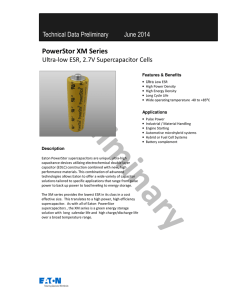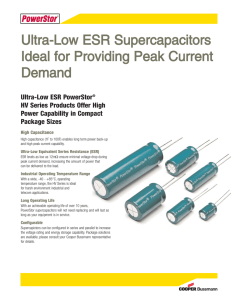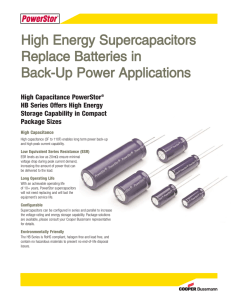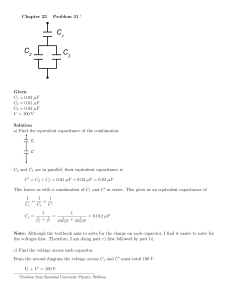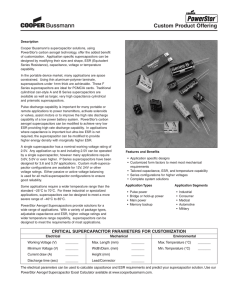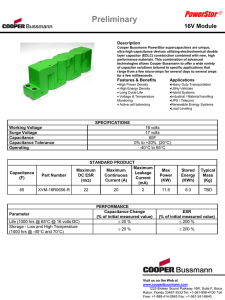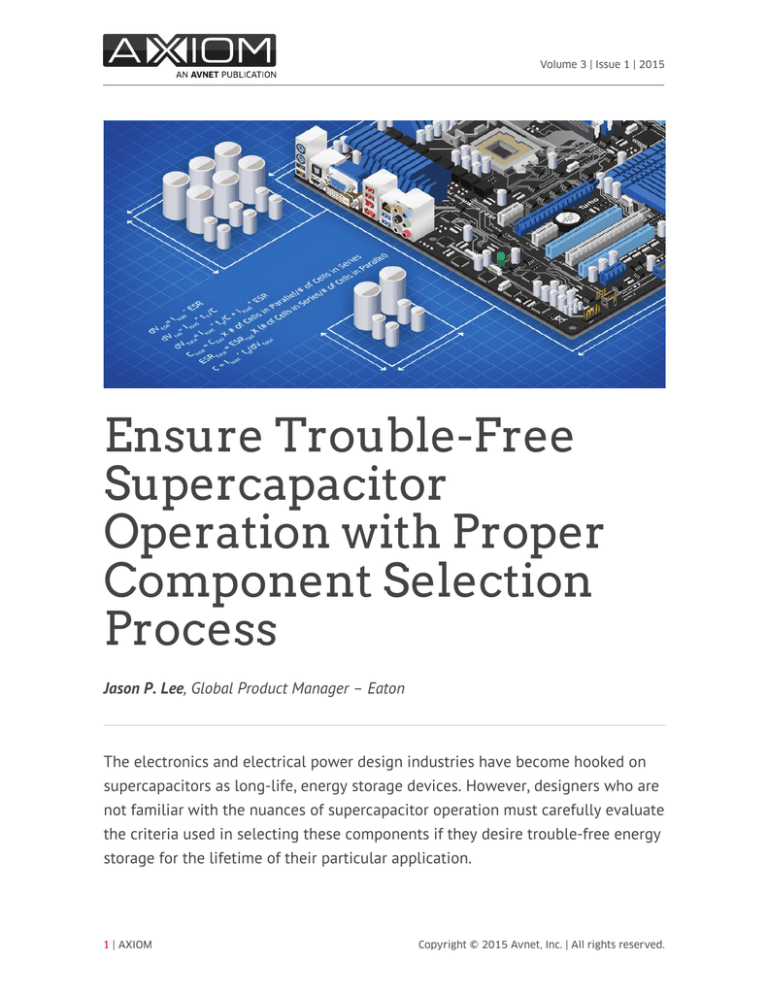
Volume 3 | Issue 1 | 2015
Ensure Trouble­Free
Supercapacitor
Operation with Proper
Component Selection
Process
Jason P. Lee, Global Product Manager – Eaton
The electronics and electrical power design industries have become hooked on
supercapacitors as long-life, energy storage devices. However, designers who are
not familiar with the nuances of supercapacitor operation must carefully evaluate
the criteria used in selecting these components if they desire trouble-free energy
storage for the lifetime of their particular application.
1 | AXIOM
Copyright © 2015 Avnet, Inc. | All rights reserved.
Volume 3 | Issue 1 | 2015
For this reason, valuable sizing and selection criteria are offered below to provide
insight into the first steps in choosing the proper supercapacitors. These are the
initial stages used to ensure a lifetime of operation over millions of load cycles.
Designers implementing
supercapacitors require basic
system requirements to begin
sizing. The selection process
involves key considerations and
calculations that will lead to
accelerated circuit design integration. The effects of temperature and equivalent
series resistance (ESR) will be introduced and some preliminary equations will
provide designers with some insight on how to ensure long life.
To select the right supercapacitor for an application, designers will need to know
these four basic requirements:
▸ Normal operating voltage
▸ Minimum operating voltage or cutoff voltage for the device
▸ Current or power
▸ Duration of pulse or hold-up time
Ambient temperature profiles will aid in selection. Temperature and voltage are
key factors affecting lifetime. Operating temperature range and life will enable a
designer to anticipate changes in the supercapacitor parameters over time and
ensure sufficient design margin selection.
2 | AXIOM
Copyright © 2015 Avnet, Inc. | All rights reserved.
Volume 3 | Issue 1 | 2015
Additional evaluation criteria:
▸ Balancing circuit and cell leakage currents.
▸ Life/aging due to temperature and time.
▸ Initial tolerance.
▸ DC resistance. This is a critical parameter as it affects the effective operating
voltage drop and operating temperature rise due to current.
Voltage Drop
During discharge there is an initial voltage drop due to the equivalent series
resistance (ESR). This is followed by a voltage drop due to the reduction in
energy stored. These are known as resistive and capacitive voltage drops and it’s
important to consider both. The capacitive component represents the voltage
change due to the real energy delivered by the supercapacitor. The resistive
component represents the voltage change due to the ESR.
Temperature and voltage directly affect the life and aging of supercapacitors.
Life extends approximately 2.2 times for every 10 degrees Celsius, 2.2 times for
every 0.2-volt (V) reduction, and the Arrhenius plots shown below helps to
visualize the temperature and voltage effects. (Note that these values are
approximations and vary by manufacturer, design and voltage.)
3 | AXIOM
Copyright © 2015 Avnet, Inc. | All rights reserved.
Volume 3 | Issue 1 | 2015
Temperature also has an effect on the operation of supercapacitors. The ESR
increases at lower temperatures. Higher ESR will increase the voltage drop and
should be accounted for in any design. Capacitance is also affected by
temperature, although to a much less extent. Capacitance decreases as
temperature decreases and increases as the temperature increases. The initial
capacitance tolerance is the possible variation or change of capacitance a
capacitor may have from lot to lot and should be considered during the sizing
process.
Series or Parallel?
Supercapacitors can be designed in series or in parallel to achieve various
voltage and energy levels. Placing capacitors in series will increase the voltage
rating by adding the voltage rating of each supercapacitor in series. So, two 2.5 V
caps in series will achieve a 5 V rating. However, when placing capacitors in
series, the capacitance will decrease and ESR will increase. So, two 5-farad (F)
supercapacitors in series will equate to 2.5 F with an ESR that is two times the
listed rating.
4 | AXIOM
Copyright © 2015 Avnet, Inc. | All rights reserved.
Volume 3 | Issue 1 | 2015
"…designers who are not familiar with the nuances of
supercapacitor operation must carefully evaluate the
“
criteria used in selecting these components if they desire
trouble­free energy storage for the lifetime of their
particular application."
Energy storage can be increased by placing capacitors in parallel. Capacitance
increases by adding the capacitance rating of a cap in parallel. If two 5 F caps in
parallel would equal 10 F, the ESR will decrease and the voltage rating will not
change.
Useful Equations
There are a few equations used in the initial stages for selecting and sizing. In
the examples below, the first solves the initial voltage drop due to ESR, the
second solves the initial voltage drop due to capacitance. The third combines
equation one and two and will solve for the total voltage drop.
Initial drop in voltage is due to the (ESR):
▸ The amount of drop is a function of the ESR and discharge current as
indicated by the equation below:
Equation 1: dVESR = Iload * ESR
▸ The capacitor will discharge according to its capacitance:
Equation 2: dVcap = Iload * td/C
5 | AXIOM
Copyright © 2015 Avnet, Inc. | All rights reserved.
Volume 3 | Issue 1 | 2015
▸ By placing these two equations together the total voltage drop:
Equation 3: dVTotal = Iload * td/C + Iload * ESR
▸ Equation four solves for the total capacitance value:
Equation 4: CTotal = CCell X # of Cells in Parallel / # of Cells in Series
▸ Equation five solves for the total ESR:
Equation 5: ESRTotal = ESRCell X (# of Cells in Series/# of Cells in Parallel)
After determining the basic formulas and parameters needed, examples can help
a designer work through these calculations. The example below uses a constant
current application. To start the designer will initially ignore the ESR effect on
the voltage drop to get an estimate on the capacitance and then use Equation 3
to verify if the size picked will work with the ESR effect. Equation 6 is created by
removing the ESR portion and rearranging the equation to solve for capacitance.
Using the formula C = Iload * td/dVTotal , the result is C = 4*5 / (16-9) = 2.86 F. This
is the total capacitance at 16 V. Since supercapacitor cells are typically rated at
2.5 V or 2.7 V then, divide the operating voltage VWV by 2.7 and round up, 16/2.7
= 5.9. This means the designer will need 6 cells in series. Since capacitance
divides with cells in series, the designer will need to calculate the capacitance
needed per cell.
Designers have several more calculations and considerations to make when
selecting the proper supercapacitor for their applications. Supercapacitor
calculators available for download make this process easier and the one that
6 | AXIOM
Copyright © 2015 Avnet, Inc. | All rights reserved.
Volume 3 | Issue 1 | 2015
Eaton provides is just one example. Visit www.eaton.com/elx
(http://www.eaton.com/elx) and click the “Supercapacitor Calculator” link to find
out more.
JASON P. LEE
Jason Lee is Global Product Manager for Eaton and has worked
developing supercapacitor products and markets since 2008. Prior to
joining Eaton, he worked at Maxwell Technologies and in the
semiconductor industry. Mr. Lee has a B.S. in Chemical Engineering
from the University of California and an MBA from Northwestern
University.
7 | AXIOM
Copyright © 2015 Avnet, Inc. | All rights reserved.

